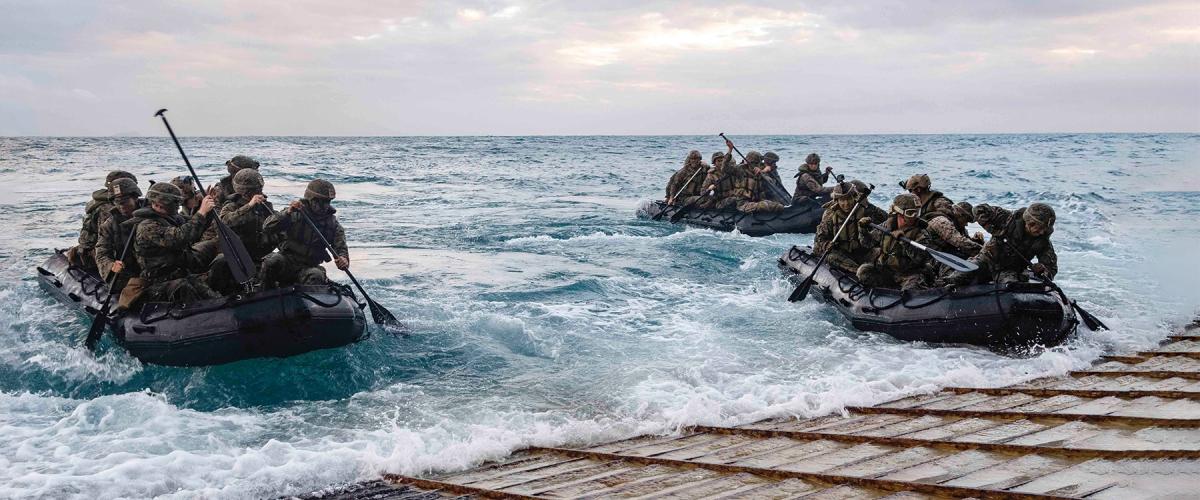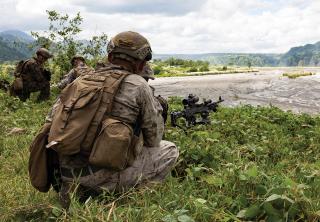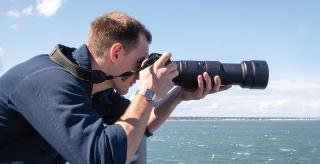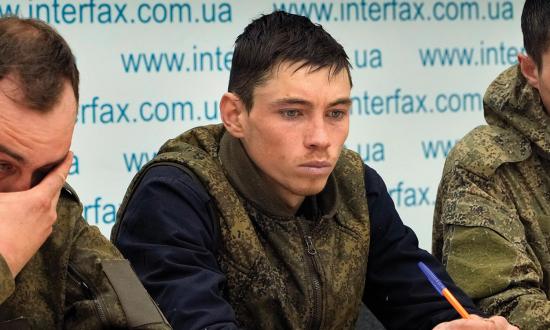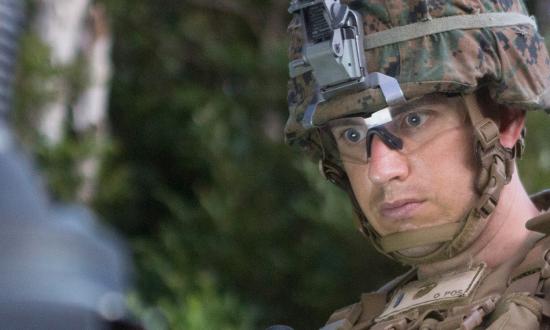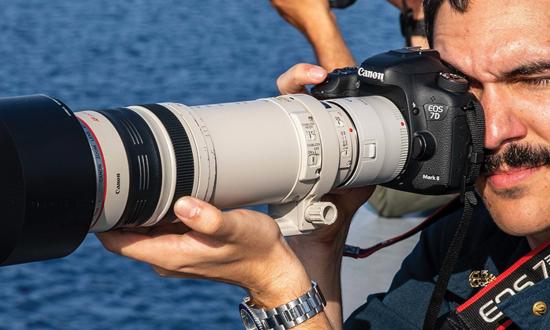The Navy and Marine Corps are seeking opportunities and pathways for increased integration, arguably at levels not seen since World War II. The current and forecasted strategic environment necessitates this integration. Gone are the days when Marine expeditionary forces owned battlespaces in locations such as Helmand Province in Afghanistan or Al Anbar Province in Iraq and moved about them as independent maneuver units. China is invigorating its antiaccess/area-denial networks and strategies to keep U.S. forces farther away and enable revisionist and expansionist aims throughout the Indo-Pacific region—and eventually globally. If the Navy–Marine Corps team is going to close with potential adversaries in this operating environment, both services must reaffirm their strategic partnership and return to a historical cooperative role of integrated littoral warfare.1
The Marine Corps’ Force Design 2030 is a substantial step in this partnership. It centers on the employment of stand-in forces (SIF), “small but lethal . . . forces designed to operate across the competition continuum to intentionally disrupt the plans of a potential or actual adversary.”2 These forces both occupy and are supported by expeditionary advanced bases (EABs), a concomitant operational concept that seeks to employ “low signature . . . naval expeditionary forces . . . within a contested or potentially contested maritime area to conduct sea denial, sea control, or enable fleet sustainment.”3 These are radically different and threat-informed approaches compared with how the Marine Corps was employed in the war on terrorism.
As these stand-in forces are intimately tied to naval forces afloat, the requirement for integration at all echelons is paramount, and this applies particularly to the intelligence warfighting function across the Sea Services. Force Design 2030 impacts naval intelligence primarily through increased integration of a supporting/supported relationship to maintain maritime domain awareness (MDA). This relationship is a two-way street, with both Navy and Marine Corps forces assuming the role of either supported or supporting element depending on what operational phase the combined force is in. Prior to emplacing SIF, a degree of awareness will be required to understand the initial operating environment, and naval intelligence can provide this as the supporting element. Once the SIF are set, they will support the fleet during this phase as the “eyes and ears of the naval and joint force,” collecting intelligence to allow decisive fleet actions.4 Moving along this supporting/supported relationship will both contribute to naval intelligence operations and capitalize on the potential of naval intelligence professionals, ultimately increasing the lethality of the combined naval team.
Conditions Set
Intelligence is a critical driver of any operation, and inserting and sustaining SIF reinforces this axiom. These forces will operate among a network of EABs, either occupying individual bases or receiving support from them.5 While the steps of the joint intelligence preparation of the operational environment are no different for EABO, according to the Tentative Manual for Expeditionary Advanced Base Operations, “The process must integrate multidomain naval considerations in the conduct of operations throughout the maritime environment” when facilitating EABO planning.6 Naval intelligence, acting as the supporting element in this instance, must gain MDA prior to the supported element, SIF, being inserted.
This multidomain integration is a requirement for which naval intelligence is uniquely suited, as it can produce estimates that allow shared understanding and decision-making across the fleet and SIF. Burgeoning doctrine supports this: “Littoral force intelligence operations enable EABO by utilizing organic intelligence resources and capabilities to support and extend the joint force maritime component commander’s maritime sensor network.”7 The only difference between legacy naval intelligence practices and this “new” integration is the customer. While naval intelligence professionals still support fleet-level decisions and actions, the Marine Corps component of this team (the SIF) is the primary user of intelligence products and estimates in this construct. Actionable intelligence will allow the insertion of SIF, which will then act as another collection platform for the fleet.
Perhaps the most important output of accurate MDA is the ensuing posture of the SIF, because these forces must balance the demands of the mission with survivability inside an adversary’s weapons engagement zone (WEZ).8 SIF prioritize gaining and maintaining contact with adversaries, and sustaining this contact (whether visually or via other means) puts the SIF at risk. All forces must include force-protection measures in operational planning and execution. The force-protection demands for SIF are unique, however, because SIF will almost assuredly be at a disadvantage in terms of size and combat power, especially considering SIF will be inside the WEZ of an area-denial network.
Moreover, this risk increases as SIF remain in place longer and their sustainment needs grow. The point of SIF is to mass sensors or fires without massing physical signature. As sustainment needs grow, so will the logistical footprint of both the SIF and the force sustaining it. As this logistical footprint grows, so does the risk the forces assume. Initial modeling and wargaming results for Force Design 2030 do not mince words when considering the disparity in combat power: “There is no avoiding attrition.”9 Responsible employment of SIF necessitates that planners and leaders gain an accurate understanding of the environment to limit such attrition. Naval intelligence professionals are the lynchpin in this understanding.
Boots on the Ground
The naval intelligence enterprise will become the supported element once SIF are ashore and maneuvering in the littorals. The awareness that enabled SIF insertion will be enhanced as the network of EABs expands and they are able to collect intelligence against adversary baselines and uncover deviations. Marine Corps intelligence personnel will collect for the naval force’s priority intelligence requirements, effectively extending the naval sensor network and overall battlespace.10 This impact does not have to stop at the naval force, as the entire joint force can benefit from a low-signature force that can maintain persistent all-domain intelligence, surveillance, and reconnaissance (ISR) on a complicated target set.11 Here is the all-important reconnaissance/counterreconnaissance fight, which is the function of SIF at every point on the competition continuum.12 Winning this fight will provide the naval and joint force with increased freedom of movement within an adversary’s WEZ and allow the fleet to persist longer inside a contested battlespace.13
The beauty of SIF is their potential to mass sensing capabilities without concentrating their physical signature.14 This complicates enemy decision-making because he is then forced to determine whether individual Marine elements or EABs cross a given target threshold, which they likely will not given their relatively small footprint (assuming they are found at all). An adversary will most likely not want to unmask and render vulnerable a weapon or sensor platform to interdict a relatively small SIF element. The adversary may be forced to make assumptions regarding the information he is ceding to U.S. forces, but these assumptions still may not be worth putting a high-value target at risk for subsequent counterattack. As SIF expand throughout an adversary’s WEZ, so too will the adversary’s uncertainty of the operating environment and the commensurate risk he is assuming.
Moreover, just like any input that changes a complex adaptive system, SIF presence will affect the adversary and the operating environment in which they both find themselves. SIF and the network of EABs will produce intelligence in isolation, regardless of the SIF’s collection priorities. This will create opportunities for littoral forces to “draw adversary forces from cover, learn their tactics, and baseline their operations.”15 This baseline will be established at all points along the competition continuum, providing joint force and component commanders with an idea of where they currently sit on the continuum, where they may be next heading, and what indicators will reveal this movement.
SIF will compel the adversary to make decisions while dealing with an ever-changing complex adaptive system, which will unmask adversary assets that otherwise would have remained hidden.16 Once unmasked, the naval and joint force can use Marine Corps forces to complete kill chains if these newfound targets warrant it.17 SIF can serve as the observer for any method of fires delivery from an adjacent U.S. or allied unit, or they can use organic assets to prosecute certain targets at the direction of the supported element.18 Ultimately, once Marines are on the ground, they support the fleet through massed sensing and fires, which allow the naval and joint force to retain the initiative, even inside an adversary’s WEZ.19 SIF place the burden of escalation on the adversary, while maintaining persistent ISR and informing the supported element what to expect.
The Marine Corps’ Force Design 2030 presents a great opportunity for naval intelligence professionals to integrate with both Marine Corps planners of SIF employment and SIF elements themselves. During planning, naval intelligence will act as the supporting element and apply its vast capabilities to gain a requisite level of MDA to allow SIF and EABO planning. This shared awareness will affect most notably the posture of Marines, who will use smaller signatures, thorough planning, and fieldcraft to offset disadvantages in size and combat power.
Once ashore and throughout the littorals, naval intelligence professionals will transition to a supported role as SIF begin to develop the battlespace and report on intelligence requirements for both the naval and joint force. Marines ashore will serve as a cost-effective supporting element, as their all-domain reporting will dwarf their physical footprint. They can then support the naval and joint force by closing these kill chains, either through observation or organic fires.
This cycle of supporting/supported integration between Marine Corps SIF and naval intelligence professionals is a requirement if the Navy and Marine Corps team is to thrive in the current operating environment and within battlespaces that will only grow more contested. Planners and leaders from both services see this opportunity and the payoffs it holds. They need to get to work now in facilitating this relationship.



